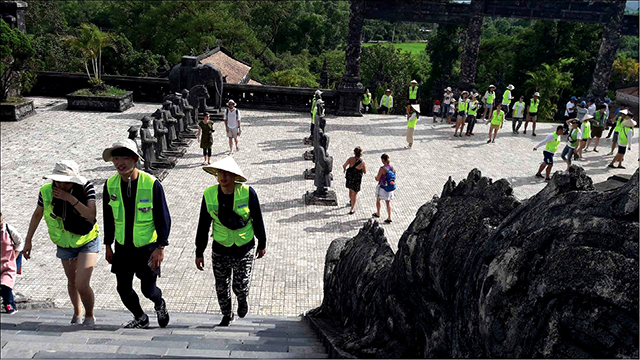
A tourist visiting Khai Dinh Tomb
In Thua Thien Hue, there are seven famous Nguyen King's tombs which are 150 years old and are all intact with unique architecture. Not to mention, Thua Thien Hue is also the land for the tombs of the Nguyen lords. Despite being re-burial sites in Huong Tho (Huong Tra), they are neatly planned and are very impressive.
Right in the center of Hue city, at the Ben Ngu slope, there is a historical relic, the tomb of patriotic scholar Phan Boi Chau. In the north, there is the tomb of the famous general Nguyen Tri Phuong in Chi Long (Phong Dien), the shrine and the tomb of Dang Huu Pho, famous in the Can Vuong movement in Bac Vong village (Quang Dien). Down to the south, there are graves of the Northern Governor Nguyen Van Thanh in Da Le Thuong (Huong Thuy); Nguyen Cu Trinh, the official who was the pioneer in the journey of Southward expansion during the Lord Nguyen dynasties.
If Beijing (China) is proud of its Thirteen Tombs, the tombs of 13 among 16 emperors of the Qing dynasty, then the seven tombs of Nguyen Kings are worthy of a special highlight of the Hue tourism. It is worth saying that visiting the mausoleums in Hue, people would never encounter the impression of death, fear and coldness as the visit to the Thirteen Tombs, nor the feeling of belittlement and intimidation when standing in front of the too massive pyramids of the Egyptian pharaohs. At Hue's tombs, man remains the subject of architecture and nature.
It is notable that Thua Thien Hue has incorporated the Nguyen Kings’ tombs into its tourism development. In Hue travel itineraries, well-known tombs such as Minh Mang tomb, Tu Duc tomb, and Khai Dinh tomb are attractions that should not be missed. Recently, My Way tourist company in Hanoi has even opened a tour called “Visiting Ancient Hue, visiting heritages and tombs”. The itinerary is for 3 days, and tourists coming to Hue from the capital mainly visit the tombs of past kings, including Minh Mang, Tu Duc, Khai Dinh and even the tombs of eunuchs of the Nguyen dynasty on top on Duong Xuan hill at Tu Hieu pagoda.
Apart from the tombs of Nguyen Kings, the potential of tomb tourism in Hue has not been fully exploited. It is unfortunate that the tombs of the 9 lords Nguyen are still neglected. Their architecture are not particularly special but the magical nature of a land located on the upstream Huong River is truly impressive. Clearly, the Nguyen lords’ tombs can be included to the list of tourist destinations during the exploration of the upstream Perfume River, which is associated with famous monuments such as Thien Mu Pagoda, Hon Chen Temple , Minh Mang Tomb near the fork Bang Lang, a convergence of two Huu Trach and Ta Trach rivers into the Huong River.
Recently, especially after the visit to Hue of the Japan Emperor, the tomb of the famous patriot Phan Boi Chau of the Dong Du movement, has become a highlight for those who want to discover Hue city. The feature of this relic is a rather new architecture style. A typical example for this is the worship house that was built from April, 1955 to 1956. It is a large brick house with a yin-yang tile roof, facing the tomb of Phan Boi Chau. The worship house was designed by Ton That Sa. Even Phan Boi Chau’s tomb was built simply and impressively, creating cultural diversity.
Enthroned at the age of 20, King Tu Duc started to build a tomb for himself in 1864, and it was completed three years later. Emperor Tu Duc died in 1883, which means that after the construction of the tomb, this Nguyen King lived for 16 more years. The tomb area was therefore the second palace and King Tu Duc called it "my castle home". In fact, the tomb of Tu Duc is considered a poetic masterpiece, a painting of nature, suggesting a "romantic soul" (une douce rêve). It is this difference of the monuments in Hue, highlighted by Tu Duc Tomb, that has made this type of tourism become specialties, existing nowhere else but Hue.
By Dong Van
